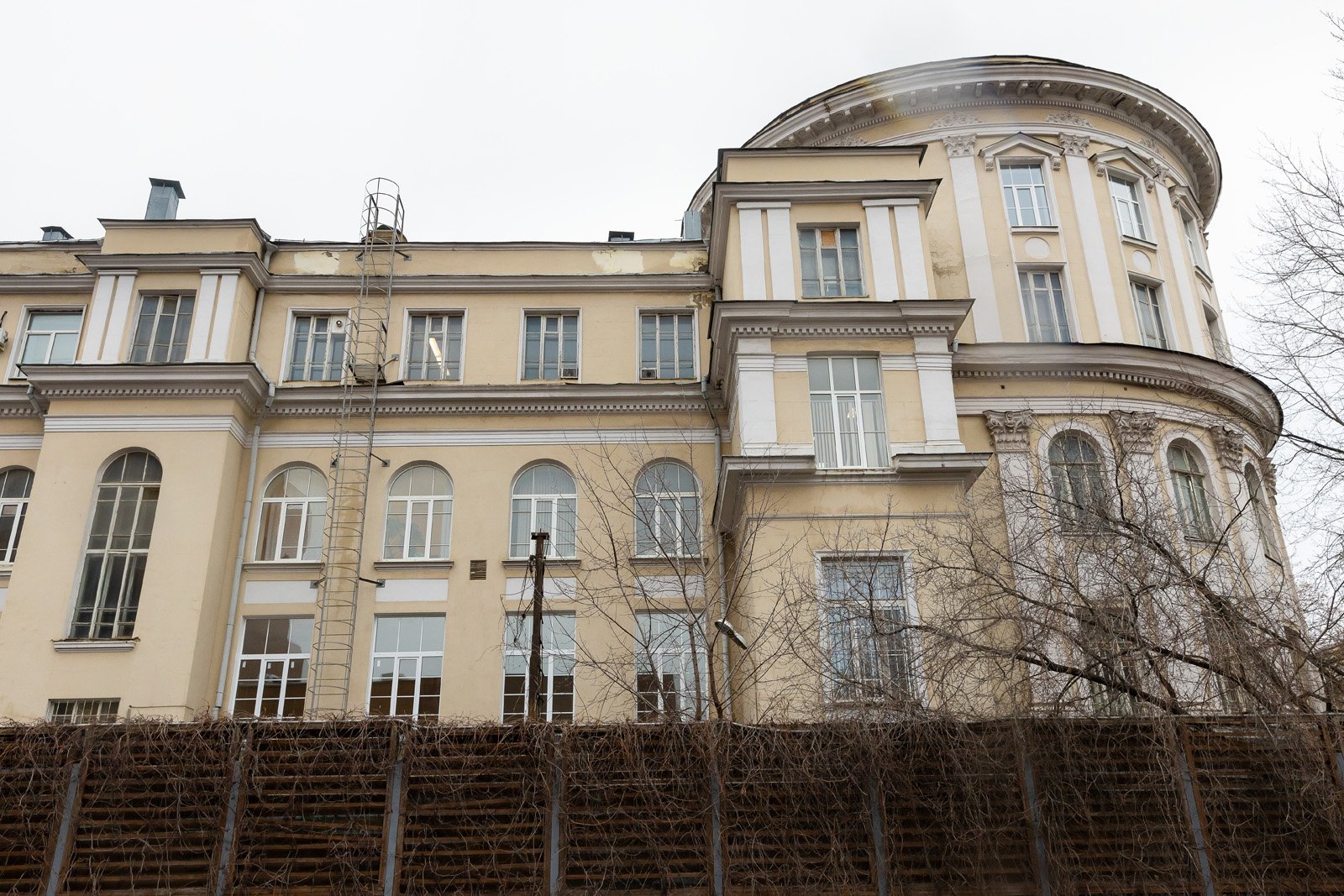Здание Анатомического театра было возведено в числе первых построек для Московских Высших женских курсов (МВЖК), которые, в свою очередь, во второй половине XIX века были единственной возможностью для женщин получить высшее образование. Но важно отметить, что только в 1915–1916 учебном году Московским высшим женским курсам было предоставлено право проведения выпускных экзаменов и выдачи дипломов именно о высшем образовании.
Итак, курсы под руководством профессора В.И.Герье начали работать с 1 ноября 1872 года и располагались на Волхонке в 1-й мужской гимназии. Собственными зданиями МВЖК обзавелись только после того, как в 1906 году был выработан Устав, вводивший факультетскую структуру: историко-филологический, физико-математический и медицинский факультеты. Московская Городская Дума выделила земельный участок, и 3 июня 1907 года состоялась закладка учебных зданий по Малой Царицынской (ныне Малая Пироговская) улице. В 1907–1908 гг. были построены физико-химический корпус (ныне Московская академия тонкой химической технологии) и Анатомический театр (ныне Российский государственный медицинский университет имени Н.И.Пирогова, а также судебно-медицинский морг № 2). Строительными работами по Анатомическому театру руководил известный московский зодчий Сергей Устинович Соловьев. Там читались публичные лекции по анатомии человека и судебной медицине с демонстрационными вскрытиями.
Согласно первоначальному проекту, здание имело три этажа и представляло собой главный цилиндрический объем, к которому было пристроено небольшое по размерам прямоугольное строение. Центр цилиндрической части занимала лекционная аудитория. В остальных помещениях были секционные залы, оборудованный по всем правилам морг, библиотека, а также кабинеты для исследовательской деятельности и педагогической работы.
В последующие годы Анатомический театр неоднократно реконструировали, меняли планировку, надстраивали. Так, уже советское время к старому зданию с ротондой, выходящей в Хользунов (бывший Трубецкой) переулок, сделали пристройку, которая хорошо видна со двора: над торжественным портиком «читаются» цифры года окончания этой постройки – "МСМХХХVI". Автором пристройки был архитектор Н.И.Транквиллицкий. В 1990-х здесь соседствовали морг и чебуречная, что служило поводом для множества шуток.
Стремление расширить историческое здание было связано с увеличением количества кафедр медицинского факультета, что требовало дополнительных помещений для организации учебного процесса. И все же до сих пор на фасаде, в межоконном пространстве между третьим и четвертым уровнями, можно разглядеть старую надпись еще с буквами «i» и «ъ» – «Анатомическiй театръ».
Анатомический театр – выявленный объект культурного наследия.
Автор статьи
The Courses led by Prof. V.I. Guerrier were opened on November 1, 1872 in Volkhonka, at the 1st male high school. Only in 1906 the MHWC got its own building, when the Statute was adopted, foreseeing the structure of the following departments: history and philology, physics and mathematics, and medicine. The Moscow City Duma allocated a land and on June 3, 1907, the first stones were laid in the foundations of the Courses buildings on the Malaya Tsaritsinskaya (now Malaya Pirogovskaya) street. In 1907–1908, the building of the physics and chemistry department (now the Moscow Academy of Fine Chemical Technologies) and the Anatomy Theater (now the N.I.Pirogov Russian State Medical University and forensic morgue No. 2) were constructed. The construction of the Anatomy Theater was supervised by the prominent Moscow architect Sergey U. Solovyov. The Theater was used for public lectures on human anatomy and forensic medicine as well as for illustrating dissections.
Under the original design, the building had three floors and a main cylindrical mass with a comparatively small rectangular annex. The lecture hall was in the center of the cylindrical part. In the other parts, there were dissection rooms, a state of the art morgue, a library as well as rooms for research and academic activities.
Later, the Anatomy Theater underwent numerous reconstructions, layout changes, and extensions. So, in the Soviet times, the old building with a rotunda along the Kholzunov (former Trubetskoy) lane, was extended with an annex that is clearly visible from the courtyard: above the stately portico, the year of the end of construction is visible: МСМХХХVI. The annex was designed by architect N.I.Trankvillitsky. In 1990s, a morgue and a cheburechnaya (an eatery specialized in meat-pastry) were neighboring here which fact was a subject of many a joke.
The need to expand the historical building was caused by the ever growing number of the chairs within the department of medicine and the want of additional space for academic process. Still, even today, on the facade between the third and fourth levels, one can see the old embossed lettering according to pre revolution spelling: Anatomy Theater.
The Anatomy Theater is a newly identified cultural heritage site.
Evgenia Tvardovskaya










%20BEL_0521.jpg&w=1920&q=75)









